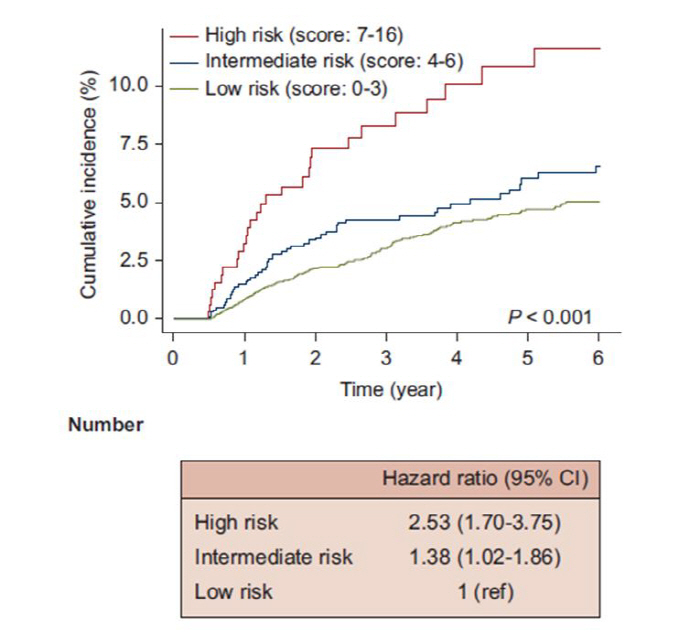Diabetes, anemia, gastric ulcer, 女, and blood cancer caution when diagnosing asymptomatic protein abnormalities
Sep 02, 2025
|
A research team at the Multiple Myeloma Center at the Catholic University of Korea's St. Mary's Hospital in Seoul has developed a 'prediction model' that identifies five risk factors that increase the risk of asymptomatic monoclonal gammopathy of Unterminated Significance (MGUS) patients progressing to multiple myeloma, a blood cancer.
The study, which was jointly conducted by professors Park Sung-soo (co-corresponding author) and Min Chang-ki (co-author) of the Department of Hematology at a blood hospital and professors Han Seung-hoon (co-corresponding author) and Choi Soo-in (co-author) of the Pharmacology Class at Catholic University of Medicine, analyzed the prognosis of 5,361 patients diagnosed with MGUS for 15 years from 2007 to 2022.
MGUS is a disease in which abnormal monoclonal immunoglobulins (proteins) are detected in the blood, and are often found by accident. Conventionally, even if diagnosed, it does not cause symptoms or pathological symptoms in patients, so it has been regarded as a disease that does not require immediate treatment. However, as it occurs when plasma cells proliferate abnormally and accumulate in the bone marrow at the same time, it can progress to malignant tumors with a probability of about 1% every year, so it should be viewed as a prodromal disease of multiple blood cancer myeloma.
Studies have shown that the risk of malignant progression in MGUS patients is greater than previously known. Of the total subjects, 345 (6.4%) were diagnosed with multiple myeloma. Of the patients diagnosed with multiple myeloma, 253 (73.3%) were confirmed to have progressed to symptomatic multiple myeloma with substantial symptoms or organ damage.
Risk factors that significantly increase the risk of multiple myeloma progression in MGUS patients were ▲female, ▲chronic lung disease, ▲gastric ulcer disease, ▲diabetes, and ▲non-tumor blood disease (anemia, thrombocytopenia, etc.). The research team scored risk factors and classified patients into three groups: low risk (0-3), medium risk (4-5), and high risk (7 points or more), and confirmed that high-risk patients have a 2.5 times higher risk of being diagnosed with multiple myeloma.
In particular, the incidence of MGUS is also increasing due to the development of diagnostic technology with aging, but there was no practical tool to select patients at high risk of progressing to blood cancer. Accordingly, the research team is sharing the results for free with a web-based application (R-Shiny) to help predict early in various treatment sites, which is expected to be of practical help to public health.
Professor Park Sung-soo said "In the meantime, among patients diagnosed with MGUS, female elderly patients with risk factors identified by this study needed to be observed more closely even if they had no symptoms."However, it has been difficult for medical staff to judge because there has been no monitoring system for medical staff to observe patients, but this evaluation tool developed by analyzing risk factors has provided a scientific basis for closer follow-up treatment of individual patients."
Professor Min Chang-ki expected that "As this predictive model is quantified based on complex health conditions rather than a single factor, it is a tool that can be applied directly to the treatment site, so it can be easily used in primary care institutions, enabling early identification of MGUS high-risk patients.'
Meanwhile, multiple myeloma occurs in the bone marrow and is a representative blood cancer that occurs frequently following malignant lymphoma and leukemia.
According to data from the Health Insurance Review and Assessment Service, the number of patients in Korea who visited the hospital with multiple myeloma doubled from 5,566 in 2014 to 11,219 in 2024. More than 2,000 people are newly diagnosed in Korea every year, and the incidence rate is steadily increasing with the increase of the elderly population.
The age group of patients with multiple myeloma in Korea has increased since their 50s, and more than 80% are known to be in their 60s or older, and it is an incurable disease that causes serious complications such as fractures, anemia, and kidney failure by cancer cells invading bones. Although the survival rate of patients has improved significantly with the recent development of various treatments, it is still a blood cancer that patients fear because recurrence is frequent and there are many patients who do not respond to existing treatments.
The study was recently published in the official journal ESMO Open (Impact Factor=8.3) of the European Society of Oncology, receiving international attention in that it is the first quantitative analysis and prediction tool based on national health care big data.
|
This article was translated by Naver AI translator.















